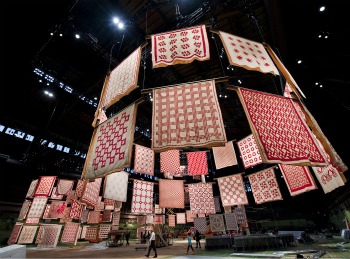What museum wouldn’t love an exhibit that attracts 5,000 people a day? Using the recent worldwide tally of attendance by The Art Newspaper for context, an exhibition of that popularity on a daily basis would have ranked 28th on the most popular list in 2010 — right behind Bauhaus at the Museum of Modern Art and right ahead of Gabriel Orozco, also at MoMA.
 So the Park Avenue Armory has something to brag about, and it did (in a press release). Infinite Variety: Three Centuries of Red and White Quilts, a show of 651 such examples that was “presented” by the American Folk Art Museum, attracted nearly 5,000 people a day in its recent six-day run. Just quilts! And more quilts of two hues than anyone probably imagined, really.
So the Park Avenue Armory has something to brag about, and it did (in a press release). Infinite Variety: Three Centuries of Red and White Quilts, a show of 651 such examples that was “presented” by the American Folk Art Museum, attracted nearly 5,000 people a day in its recent six-day run. Just quilts! And more quilts of two hues than anyone probably imagined, really.
But in the Armory’s eight-story drill hall, hung mainly on circular rods that spiraled as much as 45 feet into the air, the quilts (owned by Joanna S. Rose, whose family paid for the exhibition) really were a spectacle. I enjoyed seeing them.
Now, it’s true that no one knows what would have happened if A) the exhibit lasted longer and B) it wasn’t free. Still, plenty of museums in The Art Newspaper’s annual list are free. For the quilts, people came from as far away as New Zealand, Japan, South Africa and Australia, according to the Armory.
Here’s another comparison: Leonardo’s Last Supper: A Vision By Peter Greenaway, which ran at the Armory from Dec. 3, 2010, through Jan. 6, 2011, received nearly as many visitors — about 24,000, the Armory says — in the course of about a month. Of course, general admission tickets for Greenaway cost $15 ($12 for senior, students, etc.).
I don’t want to stretch the point too far, but the quilt show has legs and should travel, BUT:
First, it needs a catalogue (now in preparation). At the Armory, there was almost no context; there wasn’t even a checklist with origin or dates, etc. A proper museum exhibition requires some scholarship. This was more spectacle than exhibit.
And, of course, the Rose family could pay for it, as they did at the Armory: that’s renting out a museum aka pay to play (I addressed single-collector shows here).
Infinite Variety raises another question: the financial woes of the American Folk Art Museum are well known, and popular exhibits won’t solve its money problem. But AFM’s attendance hovers around 160,000 a year, according to recent reports. Could it be higher? More important, how can it use this success to attract more support, both from visitors and funders?
Photo Credit: Gavin Ashworth, Courtesy of the Park Avenue Armory
